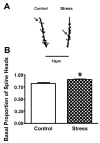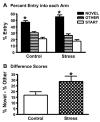Chronic stress enhances spatial memory in ovariectomized female rats despite CA3 dendritic retraction: possible involvement of CA1 neurons
- PMID: 16165283
- PMCID: PMC1380305
- DOI: 10.1016/j.neuroscience.2005.06.083
Chronic stress enhances spatial memory in ovariectomized female rats despite CA3 dendritic retraction: possible involvement of CA1 neurons
Abstract
Emerging data report sex differences in how the brain responds to chronic stress. Here, we investigated the effects of chronic restraint stress (6 h/day/21 days) on hippocampal morphology and function in ovariectomized female rats. Chronic restraint stress caused CA3 apical dendritic retraction in short- and long-shafted neurons, while it reduced basal dendritic arbors in long-shafted neurons only. Chronic restraint did not affect CA1 dendritic arborization, although it increased the proportion of CA1 spine heads compared with controls. Both stressed and control animals performed well on the Y-maze, a spatial memory task. However, chronic stress enhanced Y-maze performance compared with controls, which may reflect facilitated spatial memory or reduced habituation. Y-maze performance correlated with CA1 spine head proportion. This relationship suggests that spatial ability in females may be more tightly coupled with CA1 morphology, which may override the influence of CA3 dendritic retraction. Thus, this research provides additional evidence that CA3 morphology does not always parallel spatial memory.
Figures





References
-
- Ackermann M, Matus A. Activity-induced targeting of profilin and stabilization of dendritic spine morphology. Nat Neurosci. 2003;6:1194–1200. - PubMed
-
- Atkinson HC, Waddell BJ. Circadian variation in basal plasma corticosterone and adrenocorticotropin in the rat: Sexual dimorphism and changes across the estrous cycle. Endocrinology. 1997;138:3842–3848. - PubMed
-
- Bannister NJ, Larkman AU. Dendritic morphology of CA1 pyramidal neurones from the rat hippocampus: I. Branching patterns. J Comp Neurol. 1995;360:150–160. - PubMed
-
- Beck KD, Luine VN. Sex differences in behavioral and neurochemical profiles after chronic stress: role of housing conditions. Physiol Behav. 2002;75:661–673. - PubMed
-
- Becker JB, Snyder PJ, Miller MM, Westgate SA, Jenuwine MJ. The influence of estrous cycle and intrastriatal estradiol on sensorimotor performance in the female rat. Pharmacol Biochem Behav. 1987;27:53–59. - PubMed
Publication types
MeSH terms
Grants and funding
LinkOut - more resources
Full Text Sources
Medical
Miscellaneous

